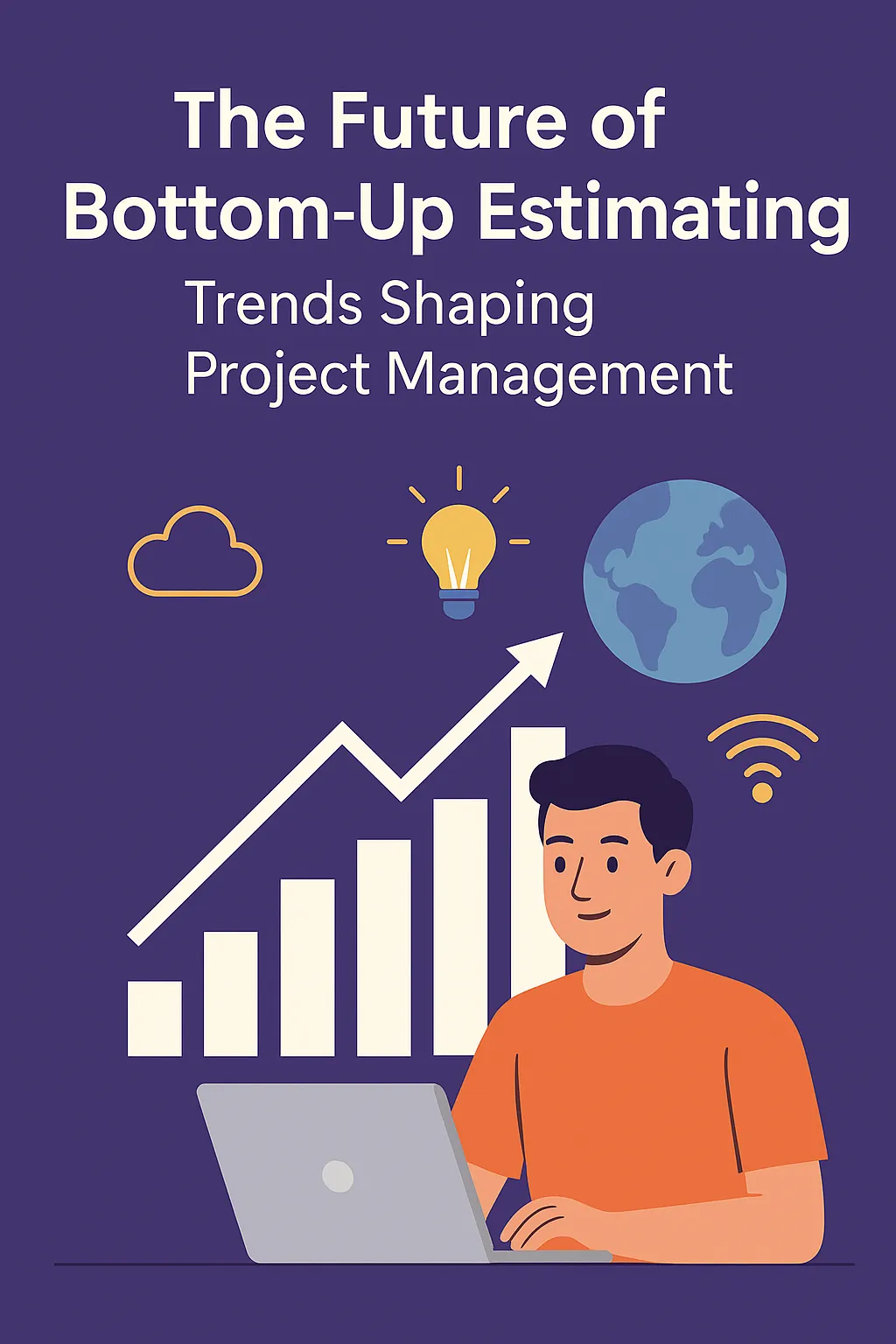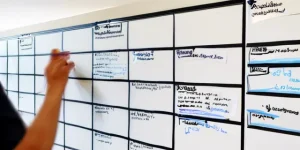Introduction to Bottom-Up Estimating
Bottom-up estimating is a detailed and systematic approach in project management that involves breaking down a project into its smallest components, allowing for precise estimation of costs, durations, and resource requirements. This technique starts at the granular level, assessing individual tasks or work packages, and aggregates these estimates to form a comprehensive overview of the entire project. By focusing on the minutiae, bottom-up estimating provides a high level of accuracy, making it particularly beneficial for complex projects where precision is critical [10][11][12].
Traditional Project Estimation Methods
Traditionally, project estimation has relied on methods such as top-down estimating and analogous estimating.
- Top-Down Estimating: This method involves senior management providing high-level estimates based on their experience with similar projects. While it can be quicker, it often lacks the detail necessary for accurate budgeting and scheduling [3][10].
- Analogous Estimating: Similar to top-down estimating, this technique uses historical data from previous projects to inform estimates. While it can be useful for quick assessments, it may not account for unique aspects of the current project, leading to potential inaccuracies [3][10].
These traditional methods, while useful in certain contexts, often fall short in providing the detailed insights required for successful project execution, especially in complex environments where every detail matters.
Importance of Accurate Estimating for Project Success
Accurate estimating is crucial for the success of any project. It directly impacts budgeting, resource allocation, and scheduling, which are all vital for meeting project objectives.
- Cost Control: Precise estimates help in setting realistic budgets, preventing cost overruns that can jeopardize project viability [4][11].
- Resource Management: Understanding the specific needs of each task allows project managers to allocate resources effectively, ensuring that the right skills are applied where they are most needed [14].
- Risk Mitigation: By identifying potential issues early through detailed estimates, project managers can develop strategies to address risks proactively, enhancing the likelihood of project success [14].
Current Trends in Bottom-Up Estimating
Bottom-up estimating has evolved significantly in recent years, influenced by various trends that are reshaping project management practices. This section delves into the current trends impacting bottom-up estimating, particularly focusing on the adoption of Agile methodologies, the integration of technology, and the shift towards data-driven decision-making.
Adoption of Agile Methodologies
The rise of Agile methodologies has had a profound impact on bottom-up estimating practices. Agile emphasizes flexibility, collaboration, and iterative progress, which aligns well with the principles of bottom-up estimating. Key aspects include:
- Task Granularity: Agile methodologies encourage breaking down projects into smaller, manageable tasks or user stories. This granularity allows for more accurate estimates at the individual task level, which are then aggregated to form overall project estimates [3].
- Team Involvement: Bottom-up estimating fosters greater team commitment as all project members contribute to the estimation process. This collaborative approach not only enhances the reliability of estimates but also strengthens team dynamics [2].
- Iterative Feedback: Agile’s iterative nature allows for continuous reassessment of estimates based on real-time feedback, enabling teams to adjust their plans and estimates as the project evolves [1].
Integration of Technology and Software Tools
The integration of advanced technology and software tools is transforming bottom-up estimating practices. This trend includes:
- Project Management Software: Tools designed for project management now often include features that facilitate bottom-up estimating. These tools allow teams to input detailed estimates for individual tasks, which can be easily aggregated and adjusted as needed [5].
- Automation: Automation in estimating processes reduces manual errors and speeds up the estimation phase. Software can analyze historical data to provide more accurate estimates based on past project performance [10].
- Collaboration Platforms: Technology enables better communication and collaboration among team members, making it easier to gather input for estimates and ensuring that all perspectives are considered [12].
Shift Towards Data-Driven Decision-Making
Data-driven decision-making is becoming increasingly integral to project management, including bottom-up estimating. This trend is characterized by:
- Real-Time Data Utilization: Project managers are leveraging real-time data analytics to inform their estimates. This approach allows for more accurate forecasting and helps identify potential issues before they arise [11].
- Performance Metrics: By analyzing performance metrics from previous projects, teams can refine their estimating techniques and improve accuracy over time. This historical data serves as a valuable resource for making informed decisions [13].
- Predictive Analytics: The use of predictive analytics tools enables project managers to anticipate future project needs and challenges, leading to more reliable estimates and better resource allocation [15].
Innovative Techniques in Estimating
Bottom-up estimating remains a cornerstone technique, known for its accuracy and detail-oriented approach. However, recent innovations are reshaping how project managers approach estimating, integrating new methodologies and technologies that enhance precision and efficiency. This section explores some of these innovative techniques that are influencing the future of bottom-up estimating.
1. Integration of Parametric and Three-Point Estimating
- Parametric Estimating: This technique utilizes statistical relationships between historical data and variables to create estimates. For instance, in software development, cost per line of code can be a useful metric. By applying parametric estimating alongside bottom-up methods, project managers can leverage historical data to inform their granular estimates, thereby increasing accuracy and reducing the time spent on initial assessments [6][12].
- Three-Point Estimating: This method involves calculating three different estimates for each task: optimistic, pessimistic, and most likely. By incorporating this technique into bottom-up estimating, project managers can better account for uncertainty and variability in project tasks. This approach allows for a more nuanced understanding of potential risks and helps in creating a more robust overall estimate [4][5].
2. The Role of Machine Learning and AI
The advent of machine learning and artificial intelligence is revolutionizing project estimating. These technologies can analyze vast amounts of historical project data to identify patterns and predict future outcomes with greater accuracy.
- Enhanced Accuracy: Machine learning algorithms can refine estimates by learning from past projects, adjusting for variables that human estimators might overlook. This leads to more precise cost and duration predictions, which is particularly beneficial in complex projects where traditional estimating methods may fall short [10].
- Automated Data Analysis: AI tools can automate the data collection and analysis process, allowing project managers to focus on strategic decision-making rather than manual calculations. This not only speeds up the estimating process but also reduces the likelihood of human error [10].
3. Collaborative Tools for Team-Based Estimating
The shift towards remote and hybrid work environments has prompted the development of collaborative tools that facilitate team-based estimating. These tools enable project teams to work together in real-time, regardless of their physical location.
- Enhanced Communication: Collaborative platforms allow team members to share insights and expertise, leading to more comprehensive estimates. By involving various stakeholders in the estimating process, project managers can ensure that all perspectives are considered, which enhances the accuracy of the bottom-up estimates [8].
- Real-Time Updates: Many of these tools offer features that allow for real-time updates and adjustments to estimates as new information becomes available. This flexibility is crucial in dynamic project environments where requirements and conditions can change rapidly [10].
Challenges in Bottom-Up Estimating
Bottom-up estimating is a widely recognized technique in project management, known for its accuracy and detailed insights into project costs and timelines. However, it is not without its challenges. Understanding these challenges is crucial for project management professionals and researchers looking to refine their estimating practices. Here are some key challenges associated with bottom-up estimating:
- Time Consumption and Resource Allocation: One of the most significant challenges of bottom-up estimating is the time it requires. This method involves a detailed analysis of each task within a project, which can be resource-intensive and time-consuming. Project managers must ensure that all tasks are identified and estimated accurately, which can lead to extended project timelines and increased resource allocation to the estimating phase [3][9]. This complexity can be particularly burdensome for large projects with numerous components, where the effort to gather and analyze data can detract from other critical project activities.
- Potential for Human Error: The detailed nature of bottom-up estimating increases the likelihood of human error. As team members provide estimates for individual tasks, biases and inaccuracies can creep in, leading to flawed overall project estimates. Factors such as personal bias, miscommunication, or lack of experience can result in underestimating or overestimating task durations and costs [4][13]. This risk is compounded by the fact that estimates are often based on subjective assessments, which can vary significantly among team members.
- Impact of Organizational Culture: The culture within an organization can significantly influence the effectiveness of bottom-up estimating practices. In environments where collaboration and open communication are encouraged, team members may feel more comfortable sharing their insights and providing accurate estimates. Conversely, a culture that discourages input or fosters competition can lead to incomplete or inaccurate estimations, as team members may hesitate to voice concerns or share their knowledge [12]. Additionally, if the organization does not prioritize thorough estimating practices, it may result in a lack of support for the necessary time and resources required for effective bottom-up estimating.
The Role of Data Analytics in Estimating
The integration of data analytics into bottom-up estimating processes is becoming increasingly vital. This section explores how data analytics enhances forecasting accuracy, leverages historical data for future estimations, and showcases transformative case studies that illustrate the impact of these innovations.
Improving Forecasting Accuracy
Data analytics plays a crucial role in refining the accuracy of bottom-up estimates. By utilizing advanced analytical tools, project managers can analyze vast amounts of data to identify patterns and trends that may not be immediately apparent. This analytical approach allows for:
- Enhanced Precision: By breaking down projects into granular components and applying statistical models, project managers can achieve a more precise estimation of costs, durations, and resource requirements. This method reduces the margin of error typically associated with traditional estimating techniques, which can often be overly generalized or based on assumptions rather than data-driven insights [6][10].
- Real-Time Adjustments: Data analytics enables project managers to make real-time adjustments to estimates as new information becomes available. This flexibility is essential in dynamic project environments where conditions can change rapidly, allowing for more responsive and accurate forecasting [8][9].
Leveraging Historical Data
The use of historical data is a cornerstone of effective bottom-up estimating. By analyzing past project data, project managers can inform their future estimations in several ways:
- Benchmarking: Historical data provides a benchmark against which current project estimates can be measured. By comparing similar projects, managers can identify realistic cost and time expectations, leading to more informed decision-making [5][11].
- Identifying Trends: Analyzing historical data allows project managers to identify trends in resource utilization, cost overruns, and time delays. Understanding these trends can help in predicting potential challenges in future projects and adjusting estimates accordingly [12][13].
Case Studies of Transformative Outcomes
Several case studies illustrate how data analytics has revolutionized bottom-up estimating processes, leading to improved project outcomes:
- Software Development Projects: In a recent software development project, a company implemented data analytics to assess the time and cost associated with each feature. By analyzing historical data from previous projects, they were able to refine their estimates significantly, resulting in a 20% reduction in project costs and a 15% decrease in delivery time. This case highlights the power of data-driven insights in enhancing the accuracy of bottom-up estimates [3][4].
- Construction Industry Innovations: A construction firm adopted data analytics to analyze past project performance metrics. By integrating this data into their estimating process, they improved their forecasting accuracy by 30%. This allowed them to allocate resources more effectively and minimize delays, showcasing how data analytics can transform estimating outcomes in large-scale projects [7][14].
Future Outlook: The Evolution of Bottom-Up Estimating
Bottom-up estimating remains a cornerstone technique, known for its accuracy and detail-oriented approach. This section delves into the future developments and potential of bottom-up estimating, highlighting key trends and innovations that are shaping the landscape of project management.
Upcoming Trends and Innovations in Estimating Techniques
Integration of Advanced Technologies:
- The future of bottom-up estimating is likely to be influenced by the integration of advanced technologies such as artificial intelligence (AI) and machine learning. These technologies can analyze historical data from previous projects to enhance the accuracy of estimates, making the bottom-up approach even more reliable [6][12].
- Additionally, the use of predictive analytics will allow project managers to foresee potential challenges and adjust estimates accordingly, leading to more informed decision-making [10].
Enhanced Software Tools:
- The development of sophisticated project management software is expected to streamline the bottom-up estimating process. These tools will facilitate the breakdown of complex projects into manageable tasks, automate calculations, and provide real-time updates on project progress [8][12].
- As software becomes more user-friendly and accessible, project managers will be able to implement bottom-up estimating techniques more effectively, regardless of their technical expertise [11].
Growing Importance of Remote Collaboration Tools
- The rise of remote work has necessitated the adoption of collaboration tools that support project management teams in different locations. These tools are crucial for bottom-up estimating, as they enable team members to contribute to the estimation process in real-time, regardless of their physical location [10].
- Platforms that allow for seamless communication and document sharing will enhance the accuracy of estimates by ensuring that all stakeholders can provide input and feedback on individual tasks and work packages [9][12].
Influence of Sustainability and Environmental Factors
- As sustainability becomes a priority in project management, bottom-up estimating will need to adapt to incorporate environmental considerations. This includes estimating the costs and resources required for sustainable practices, such as using eco-friendly materials or implementing energy-efficient processes [5][10].
- Project managers will increasingly need to account for regulatory requirements and the potential impact of projects on the environment, which may lead to more comprehensive and nuanced estimates [4][5].
Conclusion
The adoption of modern practices in bottom-up estimating has become increasingly significant. This technique, which involves breaking down projects into detailed components to derive accurate cost and duration estimates, not only enhances precision but also fosters collaboration among team members. By utilizing bottom-up estimating, project managers can better understand the intricacies of their projects, leading to improved planning and execution. The accuracy of this method, often cited as being within -5% to +10%, underscores its reliability and effectiveness in managing project risks and resources [10][15].
As we look to the future, it is essential for project management professionals to stay updated on the latest trends and innovations in estimating techniques. The integration of technology, such as real-time estimating tools and mobile accessibility, is reshaping how estimates are generated and communicated [6]. Embracing these advancements can provide a competitive edge and enhance overall project outcomes.
Find out more about Shaun Stoltz https://www.shaunstoltz.com/about/.
This post was written by an AI and reviewed/edited by a human.



